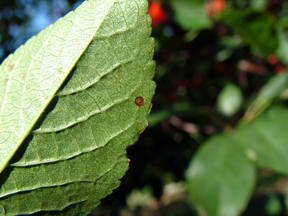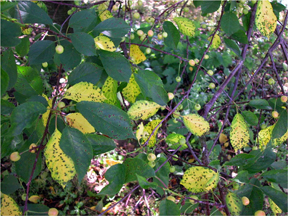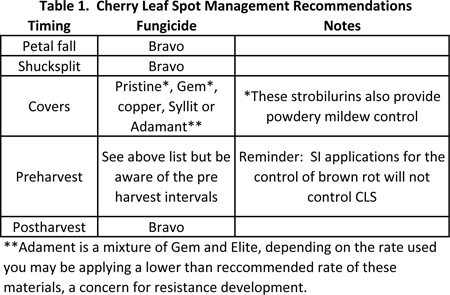Cherry leaf spot management and resistance considerations for 2011
Cherry leaf spot damage can cause significant economic loss to cherry growers in Michigan, a problem further exacerbated by fungicide resistance and warranting calculated management strategies.
Cherry leaf spot is arguably the most damaging fungal pathogen of tart cherry in Michigan. The cherry leaf spot pathogen infects foliage and reduces the photosynthetic ability of a tree through tissue degradation and early defoliation. When significant defoliation occurs before harvest, fruit may be soft and immature, have low soluble solids and ripen unevenly. For a point of reference, at least two leaves are needed to effectively ripen each cherry fruit, and defoliation that reduces leaf numbers to below that threshold can cause damage to the current year’s crop. Blossom production may also be reduced in subsequent years, and following severe defoliation, trees are more susceptible to winter injury because of the loss of stored carbohydrates in the roots.
The cherry leaf spot pathogen overwinters in fallen leaves on the orchard floor and produces apothecia (sexual spore-bearing structures) in the spring. Ascospore (sexual spore) dispersal occurs during the drying period that follows a wetting event and when temperatures are between 60-85°F. Infection occurs through the leaf stomata, which remain susceptible throughout the growing season. The primary infection period may last 2 to 6 weeks depending on conditions.
Following infection, acervuli (asexual spore-bearing structures) develop on the underside of the leaf and produce a visible mass of asexual spores called conidia (Photo 1). Spores are dispersed from leaf to leaf by wind or rain and this secondary infection cycle can be repeated several times within a season, depending on conditions (Photo 2). All commercial cherry cultivars are susceptible to cherry leaf spot. Additionally, the fungus is resistant to sterol inhibitor fungicides (Indar, Elite, Orbit) in all the major fruit producing areas of Michigan.
Table 1 below lists season-long recommendations for management. The fungicides Pristine, Gem and Adament have been in use commercially for several years now, and each of these fungicides is at risk for resistance development. Therefore, growers should be tank-mixing these fungicides with Captan (a broad spectrum fungicide) for effective fungicide resistance management. Remember to alternate the use of fungicide classes during the season to manage against resistance development and consider an early season cover that also treats for powdery mildew as early season control is key to season long suppression.
To monitor for cherry leaf spot using a disease forecasting model, visit www.enviroweather.msu.edu.



 Print
Print Email
Email




